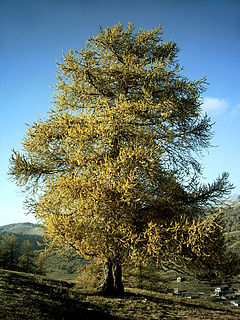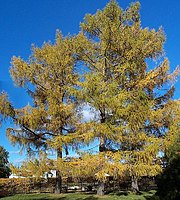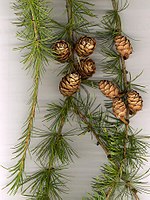begin quote from:
larches
Larch
From Wikipedia, the free encyclopedia
For other uses, see Larch (disambiguation).
| Larch | |
|---|---|
 |
|
| Larix decidua in autumn | |
| Scientific classification | |
| Kingdom: | Plantae |
| Division: | Pinophyta |
| Class: | Pinopsida |
| Order: | Pinales |
| Family: | Pinaceae |
| Genus: | Larix Philip Miller |
| Species | |
| About 10–14; see text | |
Although they are conifers, larches are deciduous trees that lose their leaves in the autumn. The shoots are dimorphic, with leave borne singly on long shoots typically 10–50 centimetres long[2]:47 and bearing several buds, and in dense clusters of 20-50 needles on short shoots[2] only 1–2 mm long with only a single bud. The leaves are needle-like, 2–5 centimetres long, slender (under 1 cm wide). The needles are deciduous, turning yellow and falling singly in the late autumn, leaving the trees leafless through the winter.
The female cones of larches cones are erect, small, 1–9 cm long, green or purple, ripening brown 5–8 months after pollination; in about half the species the bract scales are long and visible, and in the others, short and hidden between the seed scales. Those native to northern regions have small cones (1–3 cm) with short bracts, with more southerly species tending to have longer cones (3–9 cm), often with exserted bracts, with the longest cones and bracts produced by the southernmost species, in the Himalayas.[citation needed]
Contents
Species and classification
There are eleven accepted species of larch:[3]- Larix czekanowskii Szafer
- Larix decidua Mill. (syn. L. europaea D.C.) European larch. Mountains of central Europe.
- Larix gmelinii (Rupr.) Kuzen. (syn. L. dahurica) Dahurian larch. Plains of central and eastern Siberia.
- Larix griffithii Hook.f. (syn. L. griffithiana) Himalayan larch. Mountains of eastern Himalaya
- Larix kaempferi (Lamb.) Carr.(syn. L. leptolepis) Japanese larch. Mountains of central Japan.
- Larix laricina (Du Roi) K.KochTamarack larch or American larch. Parts of Alaska and throughout Canada and the northern United States from the eastern Rocky Mountains to the Atlantic shore.
- Larix lyallii (Parl.) Subalpine larch. Mountains of northwest United States and southwest Canada, at very high altitude.
- Larix mastersiana Rehder & E.H.Wilson Masters' larch. Mountains of western China.
- Larix occidentalis Nutt. Western larch. Mountains of northwest United States and southwest Canada, at lower altitudes.
- Larix potaninii Batalin Chinese larch. Mountains of southwestern China (Sichuan, northern Yunnan).
- Larix sibirica Ledeb. Siberian larch. Plains of western Siberia.
Most if not all of the species can be hybridised in cultivation.
Currently-accepted hybrids are:[3]
- Larix x lubarskii Sukaczev
- Larix x maritima Sukaczev
- Larix x polonica Racib.
Larch is used as a food plant by the larvae of a number of Lepidoptera species—see list of Lepidoptera that feed on larches.
-
Male (above) and female (below right) cones of Japanese larch emerging in spring.
-
European larch foliage and cones.
-
European larch male "flowers" or strobili.
Diseases
Larches are prone to the fungal canker disease Lachnellula willkommii (larch Canker); this is particularly a problem on sites prone to late spring frosts, which cause minor injuries to the tree allowing entry to the fungal spores. In Canada, this disease was first detected in 1980 and is particularly harmful to an indigenous species larch, the tamarack, killing both young and mature trees.[6]Larches are also vulnerable to Phytophthora ramorum. In late 2009 the disease was first found in Japanese larch trees in the English counties of Devon, Cornwall and Somerset, and has since spread to the south-west of Scotland.[7] In August 2010 the disease was found in Japanese larch trees in counties Waterford and Tipperary in Ireland[8] and in 2013 in the Afan Forest Park in south Wales.[9]
Uses
| This section does not cite any sources. (March 2016) |
Larch has also been used in herbal medicine; see Bach flower remedies and Arabinogalactan for details.
In central Europe larch is viewed as one of the best wood materials for the building of residences.[citation needed] Planted on borders with birch, both tree species[clarification needed] were used in pagan cremations.[citation needed]
Larches are often used in bonsai culture, where their knobby bark, small needles, fresh spring foliage, and – especially – autumn colour are appreciated. European larch, Japanese larch, and Tamarack larch are the species most commonly trained as bonsai.
Often, in Eurasian shamanism, the "world tree" is depicted as specifically a larch tree. [10]
References
Notes
- Stutley, Margaret. Shamanism : An Introduction. London: Routledge, 2003. eBook Collection (EBSCOhost). Web. 3 Nov. 2015.
Bibliography
- Gernandt, D. S. & Liston, A. (1999). "Internal transcribed spacer region evolution in Larix and Pseudotsuga (Pinaceae)" (PDF). American Journal of Botany (Botanical Society of America) 86 (5): 711–723. doi:10.2307/2656581. JSTOR 2656581.
- Gros-Louis, M.-C., Bousquet, J., Pâques, L. E., & Isabel, N. (2005). Species-diagnostic markers in Larix spp. based on RAPDs and nuclear, cpDNA, and mtDNA gene sequences, and their phylogenetic implications. Tree Genetics & Genomes 1 (2): 50–63. Abstract.
- Rushforth, Keith (1986) [1980]. Bäume [Pocket Guide to Trees] (in German) (2nd ed.). Bern: Hallwag AG. ISBN 3-444-70130-6.
- Semerikov, V. L., & Lascoux, M. (1999). Genetic relationship among Eurasian and American Larix species based on allozymes. Heredity 83: 62–70.
- Wei, X.-X., & Wang, X.-Q. (2003). "Phylogenetic split of Larix: evidence from paternally inherited cpDNA trnT-trnF region". Plant Systematics and Evolution 239: 67–77. doi:10.1007/s00606-002-0264-3.
- Wei, X.-X., & Wang, X.-Q. (2004). "Recolonization and radiation in Larix (Pinaceae): evidence from nuclear ribosomal DNA paralogues". Molecular Ecology 13 (10): 3115–3123. doi:10.1111/j.1365-294X.2004.02299.x. PMID 15367124.
Further reading
- Earle, Christopher J., ed. (2011). "Larix (larch) description". The Gymnosperm Database.
- Givnish, Thomas J. (2002). "Adaptive significance of evergreen vs. deciduous leaves: solving the triple paradox" (PDF). Silva Fennica 36 (3): 703–743.
The larch paradox—Finally, let us turn to one last, enduring ecological paradox: the deciduous habit of larches (Larix) at high latitudes in nutrient-poor peatlands in the northern hemisphere, where evergreen plants are expected to dominate and often do.
Quote from p. 729. - Phillips, D. H., & Burdekin, D. A. (1992). Diseases of Forest and Ornamental Trees. Macmillan ISBN 0-333-49493-8.
External links
| Wikimedia Commons has media related to Larix. |
- Eichhorn, Markus (August 2011). "The Larch". Test Tube. Brady Haran for the University of Nottingham.
 "Larch". The New Student's Reference Work. 1914.
"Larch". The New Student's Reference Work. 1914.
|
||
|
||
|
||




No comments:
Post a Comment